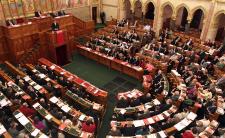The Republic of Hungary has a population of about 10 million people and is situated in the middle of Europe. It shares a border with the Czech and Slovak Republics on the north, Ukraine on the north-east, Romania on the east, Serbia and Croatia on the south, Slovenia on the southwest and Austria on the west. After years of communist rule, Hungary became a member of the North Atlantic Treaty Organization in 1999 and joined the European Union in 2004.
Political system
Hungary has a mixed system of government. The head of state is the president and the head of government is the prime minister. The legislative consists of a unicameral Parliament, a body composed of currently 386 members, which is elected every four years. Judicial power is vested in the Supreme Court named “Curia” and the Constitutional Court.
Constitutional history
Hungary was a monarchy for nearly 1,000 years and established a constitutional system earlier than other European countries. After the fall of the Austro-Hungarian empire at the end of World War I, Hungary lost much of its territory and its population. On 21 March 1919, the Hungarian Socialist Republic was established by a coalition of Hungarian Socialist Democratic Party members and communists under the leadership of Béla Kun. In 1932, Gyula Gömbös seized power and established closer ties with Nazi Germany. Following an unsuccessful attempt to change allegiance, Nazi Germany occupied the country in 1943. On 20 January 1945, a provisional government agreed an armistice with the Soviet Union and Hungary was subordinated to an Allied Control Commission with the absolute command vested in a Soviet official.
Constitution of 1949
By 1949, the Hungarian Working People's Party had assumed undisputed control of the country. On 18 August 1949, the current constitution of the Republic of Hungary was adopted. This is the country’s first written constitution. Based on the 1936 Soviet Constitution, it established “The Hungarian People’s Republic”. In the following years, the economy was transformed according to the Soviet model and freedom of press, religion, and assembly were restricted. In the 1949 constitution, the National Assembly formally seemed to be the main actor. In fact, a smaller presidium represented the real operating body. The country’s public law was largely governed by decrees instead of legislation, with the constitution setting few restrictions regarding the content of the decrees.
Amendments of 1989
It was not until the end of communism in 1989 that fundamental changes were made to the 1949 constitution. The adopted amendments transformed Hungary from a people’s republic to a republic, and made Hungary an independent democratic state founded on the rule of law. In contrast to other former communist countries, Hungary did not adopt an entirely new constitution after the end of Communism. However, the Preamble states, that the current constitution serves only as a temporary foundation of government until a new constitution is adopted. The amended constitution gave the legislature the power to control the executive, provided for a multi-party system, and established a constitutional court with the power to review the constitutionality of legal acts. Moreover, a social market economy replaced the former socialist model. From 1989 onwards, several amendments to the constitution took place.
Draft Constitution of 2011
After the elections in 2010, the new government under Victor Orbán announced plans to adopt a new constitution in order to break with Hungary’s communist past. The draft proposes a change of the country’s name from “Hungarian Republic” to “Hungary”. The draft was introduced to Parliament on 14 March 2011 and adopted by the ruling coalition on 18 April 2011. Signed the 25 April 2011, it shall come into effect on 1 January 2012. Some concerns have been raised regarding the transparency and the limited time frame of the constitution-making process. Also, the extensive use of organic laws, requiring a two thirds majority in Parliament for future modifications of laws in certain fields, as well as the Preamble which shall be used for constitutional interpretation although containing potentially controversial and vague statements has been criticised.
Executive
The president, who is nominated and elected by the parliament every five years, is the commander in chief of the defense forces and has a mainly ceremonial function. However, the president can initiate laws as well as a national referendum and dissolve the parliament in case the budget is not approved. He affirms the binding nature of international treaties, accredits ambassadors and other high officials, has the right of individual clemency and may declare a state of war or emergency if the parliament is prevented from making decisions. The president has a power of veto on acts of parliament, which he can exercise once. In addition, the president may send laws to the constitutional court for control of constitutionality.
The Prime Minister is the head of government and is appointed by the president after the election by the members of the parliament for four years. Among his tasks are the nomination of ministers and the general definition of the government’s policy. He can be replaced by a vote of no-confidence of the parliament. The government’s duties and scope of authority, on the other hand, cover all matters not specifically delegated to another authority. It is allowed to establish public administration bodies, issue decrees and manage subordinate authorities.
Legislature
The unicameral parliament is the supreme body of popular representation and elected by universal suffrage for every four years. The parliament may dissolve itself, except during a state of emergency or martial law. The parliament is also charged with enacting legislation or amendments to the constitution, concluding international agreements, declaring war or a state of emergency and making peace, electing the president, the prime minister and other high officials as well as approving the state budget. Bills may be introduced by the president, the government, parliamentary committees and members of parliament. In general, a decision is made by a simple majority of the votes. Specific areas are subject to organic laws, meaning that legislation in those areas has to be passed with a two-thirds majority. An approved act is sent to the president who has to sign it and order its publication within five days.
Judiciary
The supreme judicial body is the supreme court (Curia). Its main task is to ensure uniformity in the judicial application of laws by issuing binding decisions. Judges are appointed by the president as specified by an organic law. The Supreme Court decides on criminal and civil matters, the legitimacy of administrative decisions, the conflict of local ordinances with other legislation and their annulment.
The constitutional court has jurisdiction over all constitutional questions. It reviews the constitutionality of legislation and rules on conflicts between national legislation and international treaties. Moreover, the constitutional court is the competent jurisdiction to try impeachment proceedings brought by the legislature against the president. Under the 2011 constitution, it is no longer possible for anyone to initiate proceedings for constitutional review against a normative act after its enactment, without needing to prove that he is currently and directly affected by it. In addition, the constitutional court’s powers on budget and tax matters are restricted until debt falls below 50%.
Challenges and concerns
-
Achieving a broader acceptance for the constitution in the population due to the lack of transparency and inadequate consultation of the Hungarians in the process.
-
Emphases by the new constitution on Christian and nationalistic values has resulted in concerns from human rights organizations about the risks of discrimination.
-
The preamble is not simply declarative but the constitution’s provisions shall be interpreted in accordance with it. However, the preamble’s text lacks precision and contains a number of controversial notions, e.g. religious references. This conflicts with the ideological neutrality of the state.
-
The constitution defers to many issues for regulation by organic law, which requires a qualified majority of 2/3 of the members of parliament. While this requirement is necessary to prevent frequent changes and ensure broad consensus on most laws, it however makes it impossible for parliament to act flexibly to adapt legislation to changes in society.
-
The wide notion in the preamble that “Hungary shall bear responsibility for the fate for Hungarians living beyond its borders” may become a problem of the sovereignty of the states.
-
The scope of power of the constitutional court on budget and tax matters is restricted until debt falls below 50% and the new Budget Council has special power of intervention when the court decides over the constitutionality of the budget and taxes legislation. Moreover, the court now has to respect the “principle of balanced, transparent and sustainable budget management” when performing its duty. This may be interpreted in a way that prioritizes financial interests over infringements of fundamental rights.
-
The Minority Ombudsman, the Parliamentary Commissioner for Data Protection and Freedom of Information, and other specific bodies, are abolished and merged.
System of government (under the draft Constitution April, 25 2011)
Timeline
| 1867-1918 | Austro-Hungarian Dual Monarchy |
| March 21, 1919 | Establishment of the Hungarian Socialist Republic. |
| Aug 20, 1949 | The Hungarian Constitution [The Act No. XX from 1949], based on the 1936 Soviet fundamental law, is adopted. |
| 1956 | Popular uprising, which gradually turned into a revolution, broke out against the communist regime. The revolution was crushed by Soviet troops. |
| 1988 | The transition period from communism towards democracy began. |
| 1989 | Fundamental amendments to the 1949 Constitution. The Act No. XXXI. transforms the Stalinist Constitution in a new fundamental law, establishing the rule of law and democracy. |
| March/Apr 1990 | First free elections after 45 years; Victory of the conservative Hungarian Democratic Forum. |
| Nov 1990 | Hungary joins the Council of Europe. |
| Dec 1991 | Association Agreement signed with the EC (in force since 1 February 1994). |
| May 1994 | Second free elections, won by the Hungarian Socialist Party. |
| Apr 1994 | Hungary applies for EU accession. |
| Nov 1998 | Accession negotiations with the European Union begin. |
| March 1999 | Hungary becomes full member of NATO. |
| 2003 | Positive referendum on accession to the EU. |
| May 2004 | Hungary became a member of the EU. |
| April 25, 2011 | New constitution signed by the President. |
| January 1, 2012 | Constitution of 2011 will come into effect. |
Bibliography
- Deszo, Marta. Constitutional Law in Hungary. 2010. The Netherlands: Kluwer Law International.
- European Commission for Democracy through Law (Venice Commission). Opinion no. 618 / 2011 on the new constitution of Hungary. Web. 04 Jul 2011.
- European Commission for Democracy through Law (Venice Commission). Opinion no. 618 / 2011 on three legal questions arising in the process of drafting the new constitution. Web. 04 Jul 2011.
- Fish, Steven M., Kroenig, Matthew. The Handbook of National Legislatures. 2009. Cambridge University Press.
- Hungarian Government. The Fundamental Law of Hungary (25. April 2011). Web. 04 Jul 2011.
- Hungarian Government. The Constitution. Web. 05 July 2011.
- International Constitutional Law. Hungary Index. Web. 4 Jul 2011.
- United States. Background Note: Hungary, 2011. Web. 4 Jul 2011.
- Vince, Eszter. A summary of the controversy around the New Hungarian Constitution. Foundation For European Progressive Studies. Web. 07 Jul 2011.
| Branch | Hierarchy | Powers | Removal |
|---|


